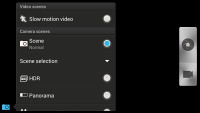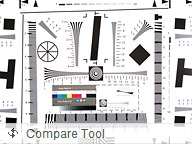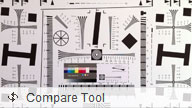HTC One X+ review: The complete package
The complete package
An improved 8MP camera
The HTC One X+ packs an 8MP camera that does stills of up to 3264x2448 pixels and records 1080p video @ 28fps. There's an LED flash to help it in low-light environments, too.
The camera interface is the same for both the still camera and the video camera - no they don't "look alike", the camera just has the UI shared between both functions.
The right-hand side features the Effects button, shutter key, camcorder record key and a shortcut to the gallery that shows the last photo taken. On the left is the flash setting toggle, a front camera switch, general settings and shot mode (we'll get back to that in a moment).
To snap a photo, you tap the shutter key. To record video you tap the button below - and you can still tap the shutter key to snap a full-res photo, even while recording video. Another cool option is the burst mode, which we mentioned in the gallery - you press and hold on the shutter key and it will snap multiple photos and let you pick which one to keep (you can keep all of them of course).
The effects button brings out a tab on the left with the usual set of color effects (sepia, solarize and so on). There's also some other cool effects such as shallow depth of field , which lets you blur parts of a photo that fall outside a predefined circular area. It's like having Intagram built right into the camera app UI.




Additional options and effects
All this is pretty cool, but we had one problem with this combined interface - if you want full 8MP resolution still shots, you have to disable the Widescreen option. But then it becomes hard to frame a 16:9 video in the 4:3 view finder. That's made even worse when shooting 720p video. The field of view in that mode is narrower than what the viewfinder shows and framing involves a lot of guesswork. We hoped the Jelly Bean update would fix these problems, but we were in no luck.
The HTC One X+ has touch focus and face detection. Geotagging and smile shutter are also available.
Continuous autofocus is supported, too, which is good to have on a phone like the One X+ with no hardware shutter key (the virtual shutter key cannot trigger autofocus either, it does burst mode). On the downside, the continuous autofocus may be way off in some shots - the only way to be certain you have it right is to tap and hold on the spot of the screen where you want the focus to be.
The shot mode button offers some more cool stuff - HDR photos, Panorama (with a gyro horizon), portrait, group portrait, landscape, whiteboard, close-up and, finally, low light.
Group portrait is quite cool - we've seen something like it before in the Scalado Rewind. It snaps multiple photos and for each face (and the One X can track many faces), the phone automatically picks the one where that person is smiling and didn't blink.
Just like the One X, the One X+ features a camera with a bright f/2.0 aperture, which lets it gather more light and do better in low-light. The image quality is close on the two smartphone, with the One X+ offering a slightly more mature noise reduction algorithm, which allows more of the fine detail to be retained in the final image.
The colors are usually slightly off on spot, but are pleasant and lively. The only major problem we found is the color fringing around certain edges and lines. Good thing is that the effect is mostly visible in high contrast fine detail areas such as our resolution chart, while on in real-life scenarios it's barely noticeable.
Surely we've seen better sharpshooters within the 8MP league, but the One X+ camera is certainly good.
We've prepared a bunch of samples for you guys below, check them out.
The camera captures images really fast, thanks to the built-in image processing chip. We also liked the fact that images (by default) don't get in the way - once you've snapped a shot it quietly pops-up in the preview box in the bottom right, without instant preview, and you're free to snap away.
Here's a comparison of a scene with HDR off and on. The smartphone tries to fit too much dynamic range in the photo, which results in a rather flat and unrealistic images. We like the more conservative approach of the Galaxy S III better here.
We also snapped a couple of close-ups with the HTC One X+. The focus innately captures macro photos but opting for the dedicated close-up preset does give you an extra millimeter or two to work with. Overall we're pleased with the amount of resolved detail and quite happy with the One X+ macro performance in general.
We also tested the HTC One X+ ability to capture high-res photos during video recording. The photos are taken in 16:9 aspect ratio and are in 3264 x 1840 resolution. The idea is that you can snap fast-paced pics while you're recording a video.

HTC One X+ 16:9 in-video sample
Photo quality comparison
The HTC One X+ joins the other 8MP shooters in our Photo Compare Tool. The tool's page will give you enough info on how to use it and what to look for.
The resolution chart clearly shows the One X+ resolves plenty of detail, but the color fringing is all over the place too. The other two charts just prove the One X+ is very good shooter but there is still room for improvement in the processing algorithm.



HTC One X+ in our Photo Compare Tool
1080p video recording is OK
The One X+ records 1080p or 720p videos at 28fps and it can snap photos simultaneously. You can also use touch focus and even toggle the video light - that's during recording!
Videos are stored in MP4 files and use H.264 encoding. 1080p videos have a rather low bitrate - 10Mbps or less and compression clearly takes its toll on the amount of detail resolved. The contrast is slightly low though and while noise is kept well under control, the One X+ isn't as good as most of the other high-end smartphones at capturing videos.
On the positive side the One X+ camera boasts stereo audio recording and keeps the framerate close to the promised fps.
The 720p videos captured by the Once X+ are decent. They only use half the bitrate (makes sense since 720p is about half as many pixels as 1080p). You should keep in mind their field of view is narrower than the 1080p videos.
Here is an untouched sample 1080p@28fps video clip (video stabilization off), 1080p@28fps video clip (video stabilization on) and a 720p@28fps video clip.
And here's a video uploaded to YouTube for you to enjoy right in your browser. Don't forget to click 1080p on the FullHD video sample and open the video fullscreen.
We've also prepared a 720p video sample taken with the One X+.
The HTC One X+ also shoots slow-motion videos but the resolution drops significantly - you get 768x432 at 2.4Mbps bitrate. HTC didn't give an official number, but we measured it at about 3x slo-mo.
Video quality comparison
We entered the HTC One X+ in our Video Compare Tool database too and put it head to head with other 1080p mobile camcorders. In good light the One X+ videos tend to be more notably more detailed than those of the One X. Low light conditions reduce the gap in performance, though.
Shooting the resolution chart though unleashes the nasty color fringing even more than on the still photos. Luckily, you'll rarely need to shoot such charts with your One X+, so it's not that bad.
Reader comments
- Djd
- 09 Dec 2013
- fuN
Ive been using my htc one x plus for over 6 mounth now after my galaxcy s2 broke......trust me or not it was the best decition ive made....this is one of the best phone....i even put my phone under the water tap to clean my screen at times and nathin...
- Karthik
- 30 Sep 2013
- vLy
I have been using HTC One X+ for few months now. Its amazing piece of engineering, sleek and beautiful. IPhone 5 is good looking than this, but considering the cost, this is more value for the bug. Specs are good. Couple of times, it became hot durin...
- Anonymous
- 23 Sep 2013
- Y6S
Thats right!!!



















